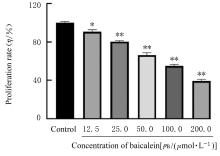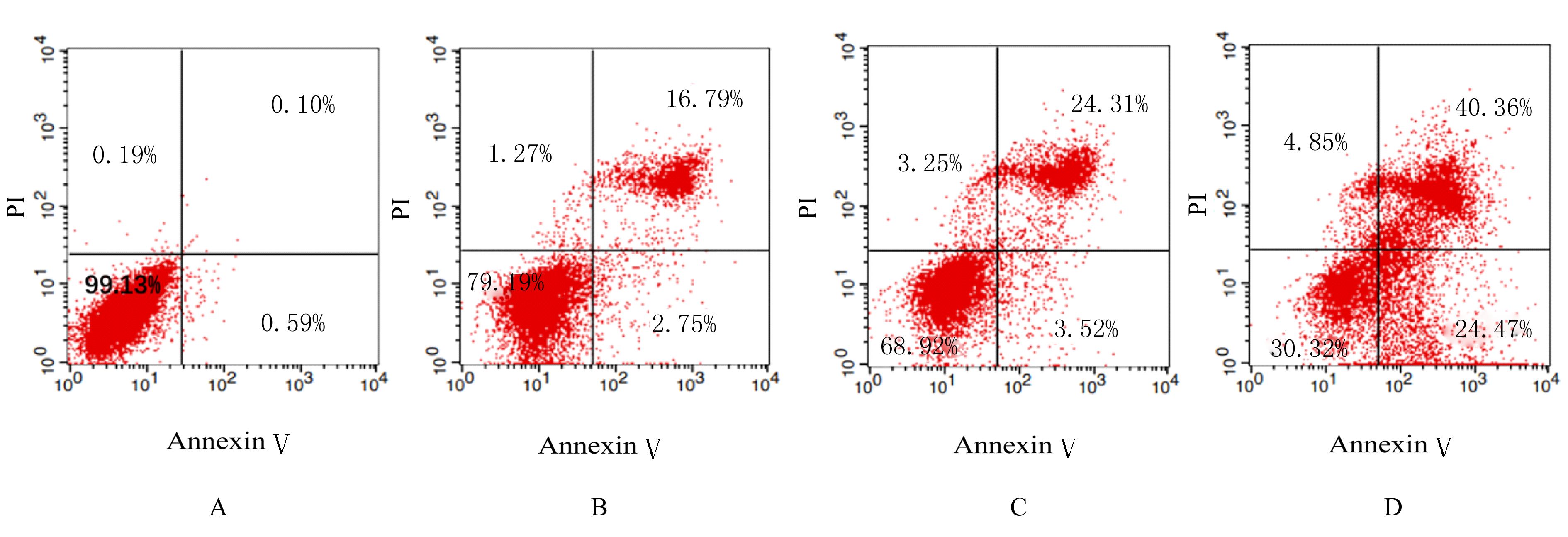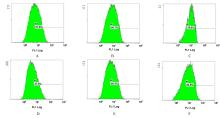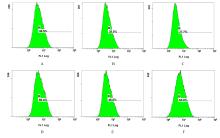| 1 |
JOHNSON D E, BURTNESS B, LEEMANS C R,et al.Head and neck squamous cell carcinoma [J]. Nat Rev Dis Primers, 2020, 6(1): 92.
|
| 2 |
KITAMURA N, SENTO S, YOSHIZAWA Y, et al. Current trends and future prospects of molecular targeted therapy in head and neck squamous cell carcinoma[J]. Int J Mol Sci, 2020, 22(1): 240.
|
| 3 |
BARADARAN RAHIMI V, ASKARI V R, HOSSEINZADEH H. Promising influences of Scutellaria baicalensis and its two active constituents, baicalin, and baicalein, against metabolic syndrome: a review[J]. Phytother Res, 2021, 35(7): 3558-3574.
|
| 4 |
LIU B Y, LI L, LIU G L, et al. Baicalein attenuates cardiac hypertrophy in mice via suppressing oxidative stress and activating autophagy in cardiomyocytes[J]. Acta Pharmacol Sin, 2021, 42(5): 701-714.
|
| 5 |
YU Z J, LI Q, WANG Y, et al. A potent protective effect of baicalein on liver injury by regulating mitochondria-related apoptosis[J]. Apoptosis, 2020,25(5/6): 412-425.
|
| 6 |
DINDA B, DINDA S, DASSHARMA S, et al. Therapeutic potentials of baicalin and its aglycone, baicalein against inflammatory disorders[J]. Eur J Med Chem, 2017, 131: 68-80.
|
| 7 |
SU M Q, ZHOU Y R, RAO X, et al. Baicalein induces the apoptosis of HCT116 human colon cancer cells via the upregulation of DEPP/Gadd45a and activation of MAPKs[J]. Int J Oncol, 2018, 53(2): 750-760.
|
| 8 |
CHEN Y, ZHANG J Y, ZHANG M Q, et al. Baicalein resensitizes tamoxifen-resistant breast cancer cells by reducing aerobic glycolysis and reversing mitochondrial dysfunction via inhibition of hypoxia-inducible factor-1α[J]. Clin Transl Med, 2021, 11(11): e577.
|
| 9 |
GAO Z L, ZHANG Y Q, ZHOU H, et al. Baicalein inhibits the growth of oral squamous cell carcinoma cells by downregulating the expression of transcription factor Sp1[J]. Int J Oncol, 2020, 56(1): 273-282.
|
| 10 |
LI B, LU M, JIANG X X, et al. Inhibiting reactive oxygen species-dependent autophagy enhanced baicalein-induced apoptosis in oral squamous cell carcinoma[J]. J Nat Med, 2017, 71(2): 433-441.
|
| 11 |
SUENAGA N, KURAMITSU M, KOMURE K, et al. Loss of tumor suppressor CYLD expression triggers cisplatin resistance in oral squamous cell carcinoma[J]. Int J Mol Sci, 2019, 20(20): 5194.
|
| 12 |
HUNG C C, CHIEN C Y, CHU P Y, et al. Differential resistance to platinum-based drugs and 5-fluorouracil in p22 phox-overexpressing oral squamous cell carcinoma: implications of alternative treatment strategies[J]. Head Neck, 2017, 39(8): 1621-1630.
|
| 13 |
ATANASOV A G, ZOTCHEV S B, DIRSCH V M, et al. Natural products in drug discovery: advances and opportunities[J].Nat Rev Drug Discov,2021,20(3):200-216.
|
| 14 |
WANG Y S, ZHANG Q F, CHEN Y C, et al. Antitumor effects of immunity-enhancing traditional Chinese medicine[J]. Biomed Pharmacother, 2020, 121: 109570.
|
| 15 |
HARADA K, FERDOUS T, KOBAYASHI H, et al. Paclitaxel in combination with cetuximab exerts antitumor effect by suppressing NF-κB activity in human oral squamous cell carcinoma cell lines[J]. Int J Oncol, 2014, 45(6): 2439-2445.
|
| 16 |
LEDWITCH K, OGBURN R, COX J, et al. Taxol: efficacy against oral squamous cell carcinoma[J]. Mini Rev Med Chem, 2013, 13(4): 509-521.
|
| 17 |
SHANG Y, JIANG Y L, YE L J, et al. Resveratrol acts via melanoma-associated antigen A12 (MAGEA12)/protein kinase B (Akt) signaling to inhibit the proliferation of oral squamous cell carcinoma cells[J]. Bioengineered, 2021, 12(1): 2253-2262.
|
| 18 |
XIAO C, WANG L L, ZHU L F, et al. Curcumin inhibits oral squamous cell carcinoma SCC-9 cells proliferation by regulating miR-9 expression[J]. Biochem Biophys Res Commun,2014,454(4): 576-580.
|
| 19 |
LI F S, WENG J K. Demystifying traditional herbal medicine with modern approach[J]. Nat Plants, 2017, 3: 17109.
|
| 20 |
CHENG C S, CHEN J, TAN H Y, et al. Scutellaria baicalensis and cancer treatment: recent progress and perspectives in biomedical and clinical studies[J]. Am J Chin Med, 2018, 46(1): 25-54.
|
| 21 |
SINGH S, MEENA A, LUQMAN S. Baicalin mediated regulation of key signaling pathways in cancer[J]. Pharmacol Res, 2021, 164: 105387.
|
| 22 |
WANG Z, MA L M, SU M Q, et al. Baicalin induces cellular senescence in human colon cancer cells via upregulation of DEPP and the activation of Ras/Raf/MEK/ERK signaling[J].Cell Death Dis,2018,9(2): 217.
|
| 23 |
ZHAO F C, ZHAO Z X, HAN Y R, et al. Baicalin suppresses lung cancer growth phenotypes via miR-340-5p/NET1 axis[J].Bioengineered,2021,12(1): 1699-1707.
|
| 24 |
POPRAC P, JOMOVA K, SIMUNKOVA M, et al. Targeting free radicals in oxidative stress-related human diseases[J].Trends Pharmacol Sci,2017,38(7):592-607.
|
| 25 |
CHEUNG E C, VOUSDEN K H. The role of ROS in tumour development and progression[J]. Nat Rev Cancer, 2022, 22(5): 280-297.
|
| 26 |
SIES H, JONES D P. Reactive oxygen species (ROS) as pleiotropic physiological signalling agents[J]. Nat Rev Mol Cell Biol, 2020, 21(7): 363-383.
|
| 27 |
YANG S S, LIAN G J. ROS and diseases: role in metabolism and energy supply[J]. Mol Cell Biochem, 2020, 467(1/2): 1-12.
|
| 28 |
SAKAMURU S, ATTENE-RAMOS M S, XIA M. Mitochondrial membrane potential assay[J]. Methods Mol Biol, 2016, 1473: 17-22.
|
| 29 |
ZOROV D B, JUHASZOVA M, SOLLOTT S J. Mitochondrial reactive oxygen species (ROS) and ROS-induced ROS release[J]. Physiol Rev, 2014, 94(3): 909-950.
|
| 30 |
QUOILIN C, MOUITHYS-MICKALAD A, LÉCART S, et al. Evidence of oxidative stress and mitochondrial respiratory chain dysfunction in an in vitro model of sepsis-induced kidney injury[J]. Biochim Biophys Acta, 2014, 1837(10): 1790-1800.
|
| 31 |
DENG X H, LIU J J, LIU L T, et al. Drp1-mediated mitochondrial fission contributes to baicalein-induced apoptosis and autophagy in lung cancer via activation of AMPK signaling pathway[J].Int J Biol Sci,2020,16(8): 1403-1416.
|
 ),Xiaofeng WANG1(
),Xiaofeng WANG1( )
)















